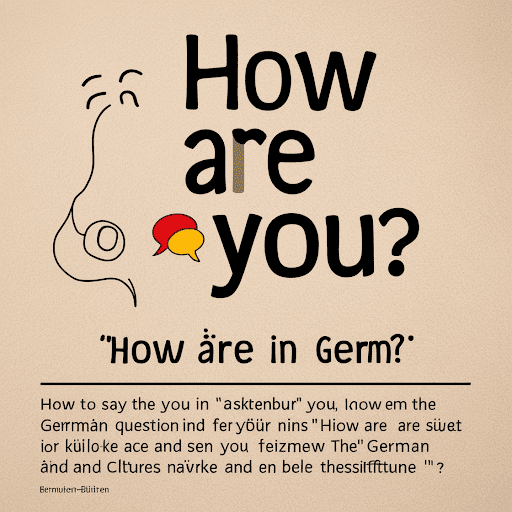When learning a new language, one of the first phrases you often learn is “How are you?” In German, this simple yet essential question is a cornerstone of conversation. Knowing how to ask this question helps you make connections and deepens your understanding of the German language and culture. This article will explore how to say “How are you in German,” the different ways to express this sentiment, and the cultural nuances behind it.
Understanding the Basics: “Wie Geht Es Ihnen?”
The most common German translation for “How are you in German” is “Wie geht es Ihnen?” This phrase is used in formal situations or when addressing someone you do not know well, such as in a business context or when speaking to elders. The word “Ihnen” is the formal pronoun used to show respect.
Using this phrase correctly is vital for making a good impression. When you welcome somebody with “Wie geht es Ihnen?” You are not simply getting some information about their prosperity; you additionally show that you esteem them and wish to participate in a well-mannered discussion.
Informal Greeting: “Wie Geht’s?”
In casual conversations, especially among friends or peers, you might use the more relaxed form “Wie geht’s?” This informal version of asking how someone is doing is a great way to foster a friendly atmosphere. The contraction “geht’s” comes from “geht es,” making it quicker and easier to say in everyday dialogue.
Understanding when to use “Wie geht es Ihnen?” and “Wie geht’s?” is fundamental for exploring different group environments in German-talking conditions. This awareness reflects your understanding of social etiquette and can help you build rapport with others.
Cultural Context: The Importance of Greetings
In German-speaking countries, greetings play a significant role in social interactions. Asking, “How are you in Germany?” Germans value directness and honesty, so your response should be genuine.
When asking about someone’s well-being, it is expected to ask about their family, work, or hobbies. Engaging in small talk is integral to building relationships in German culture. This is particularly important in settings where you might not know someone well.
Variations of “How Are You” in German
While “Wie geht es Ihnen?” and “Wie geht’s?” are the most commonly used phrases, there are other variations you might encounter:
- “Wie steht’s?” (How’s it going?)
- “Alles klar?” (Is everything clear?)
- “Wie läuft’s?” (How’s it running/going?)
These alternatives can add variety to your conversations and show your familiarity with the language. Different phrases can also help you adapt to your conversation and partner’s comfort level.
Using “How Are You” in Different Situations
Understanding how to ask “How are you in German?” is critical, yet applying it fittingly in various settings is comparatively huge. Here are some scenarios:
At Work
In a professional environment, always opt for the formal “Wie geht es Ihnen?” or “Wie geht es Ihnen heute?” (How are you today?). This shows respect and professionalism, which are crucial in business settings.
Among Friends
When chatting with friends or peers, feel free to use “Wie geht’s?” or even more casual phrases like “Na, wie läuft’s?” (So, how’s it going?). This relaxed approach fosters a friendly atmosphere.
In Social Gatherings
You might encounter a mix of formal and informal greetings at parties or gatherings. Change your language given who you are addressing. If unsure, starting with a formal greeting can help you gauge the atmosphere.
Common Mistakes to Avoid
When learning to ask “How are you in German,” some common pitfalls can lead to misunderstandings.
One mistake is using informal language in a formal setting. For instance, addressing a client with “Wie geht’s?” can come off as disrespectful. Always read the room and adjust your language accordingly.
Another standard error is not paying attention to your response. In German culture, answering questions truthfully and engaging in further conversation is essential. If someone asks how you are, they often expect a more detailed answer rather than just “good” or “fine.”
The Significance of Tone and Body Language
When asking, “How are you in German,” your tone and body language can convey a lot about your sincerity. A friendly tone coupled with a smile can make a significant difference in how your question is received.
Similarly, be mindful of your body language when receiving answers. Nodding or maintaining eye contact can show that you are genuinely interested in the other person’s response, fostering a deeper connection.
Practicing Your Skills
To effectively master how to say “how are you in German,” practice is critical. Here are some tips:
Engage with native speakers: If you can, converse with native German speakers. This will help you grasp not only the language but also the cultural context.
Use language learning apps: Many language learning apps provide interactive scenarios to practice greetings and responses, enhancing your learning experience.
Watch German films or shows: Listening to how characters interact can give you a sense of conversational flow and help you understand when to use specific phrases.
Conclusion: Embracing the German Language
Learning to ask, “How are you in German?” opens doors to meaningful conversations and relationships. Whether traveling to Germany, interacting with German-speaking friends, or simply exploring a new language, understanding greetings is fundamental.
With practice and a willingness to engage with the language, phrases like “Wie geht es Ihnen?” and “Wie geht’s?” will become second nature. Remember that communication is about connection, and asking and responding sincerely can lead to rewarding interactions.
By incorporating this phrase into your vocabulary and understanding its cultural nuances, you enrich your language skills and enhance your ability to connect with others. The German language is a treasure trove of expressions, and mastering how to say “how are you in German” is just the beginning of your linguistic journey.
